BAE Systems innovates active inceptor technology for stick to surface control
ARLINGTON, Va., - Pilots use sticks to control the movement of an aircraft – sending inputs from the stick to a flight control system that translates those inputs into commands the aircraft can perform.
As part of an aircraft’s fly-by-wire flight control system, active inceptors – also known as active sticks - provide both static and dynamic tactile force feedback to the pilot directly through the stick. It is that change in the feel of the stick that can advise or cue the pilot to respond. Those cues warn pilots of structural or aerodynamic operating limits – giving them improved situational awareness to maintain a safe and stable flight.
Traditional mechanical inceptors are unable to change the feel of the stick in real time. With active inceptors, pilots can feel the feedback or resistance in the form of vibration directly as they fly the aircraft – in real time. It alerts them if they are close to exceeding certain flight parameters.
BAE Systems is a leader in active inceptor technology with more than 25 years of experience. Early versions of their active inceptors were designed for fighter jets and appeared on the F-35 beginning in the 1990s. The technology achieved its initial flight on the aircraft in 2000, and became the world’s first certified military active inceptor six years later.
BAE's active inceptors have flown on 13 different commercial and military aircraft around the world and have logged more than 200,000 flight hours. Our inceptors have flown on the first flights of multiple aircraft, including the Embraer C-390 Millennium, Gulfstream G500 and G600, Boeing AH-64 Apache and Sikorsky CH-53K King Stallion.
